Samsung's 128 TB-Class BM1743 Enterprise SSD Displayed at FMS 2024
by Ganesh T S on August 13, 2024 2:00 PM EST- Posted in
- Storage
- SSDs
- Samsung
- Enterprise SSDs
- FMS 2024
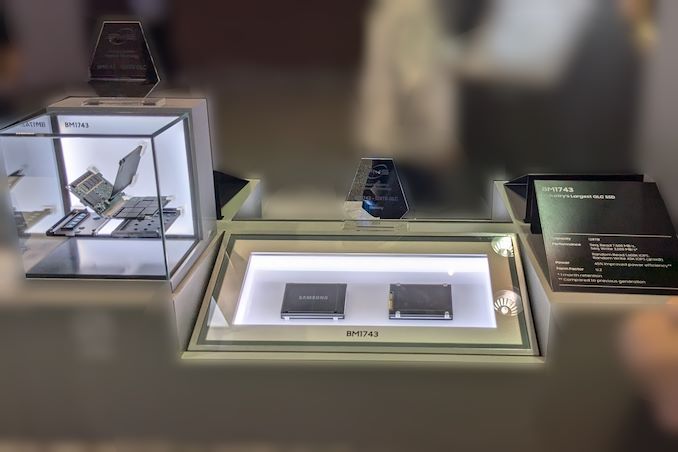
Samsung had quietly launched its BM1743 enterprise QLC SSD last month with a hefty 61.44 TB SKU. At FMS 2024, the company had the even larger 122.88 TB version of that SSD on display, alongside a few recorded benchmarking sessions. Compared to the previous generation, the BM1743 comes with a 4.1x improvement in I/O performance, improvement in data retention, and a 45% improvement in power efficiency for sequential writes.
The 128 TB-class QLC SSD boasts of sequential read speeds of 7.5 GBps and write speeds of 3 GBps. Random reads come in at 1.6 M IOPS, while 16 KB random writes clock in at 45K IOPS. Based on the quoted random write access granularity, it appears that Samsung is using a 16 KB indirection unit (IU) to optimize flash management. This is similar to the strategy adopted by Solidigm with IUs larger than 4K in their high-capacity SSDs.
A recorded benchmark session on the company's PM9D3a 8-channel Gen 5 SSD was also on display.
The SSD family is being promoted as a mainstream option for datacenters, and boasts of sequential reads up to 12 GBps and writes up to 6.8 GBps. Random reads clock in at 2 M IOPS, and random writes at 400 K IOPS.
Available in multiple form-factors up to 32 TB (M.2 tops out at 2 TB), the drive's firmware includes optional support for flexible data placement (FDP) to help address the write amplification aspect.
The PM1753 is the current enterprise SSD flagship in Samsung's lineup. With support for 16 NAND channels and capacities up to 32 TB, this U.2 / E3.S SSD has advertised sequential read and write speeds of 14.8 GBps and 11 GBps respectively. Random reads and writes for 4 KB accesses are listed at 3.4 M and 600 K IOPS.
Samsung claims a 1.7x performance improvement and a 1.7x power efficiency improvement over the previous generation (PM1743), making this TLC SSD suitable for AI servers.
The 9th Gen. V-NAND wafer was also available for viewing, though photography was prohibited. Mass production of this flash memory began in April 2024.
Source: Samsung


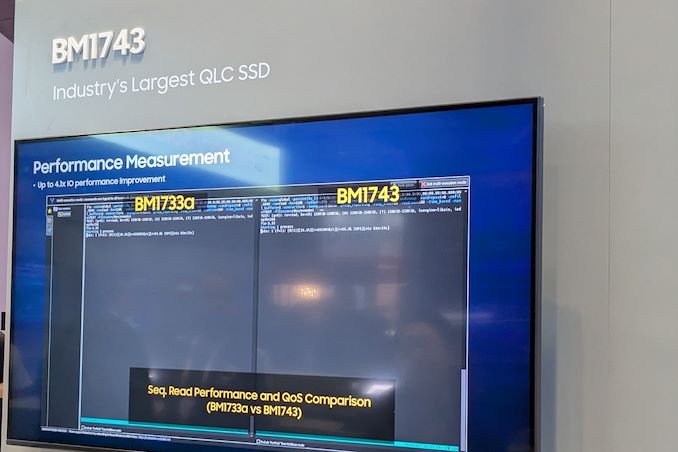
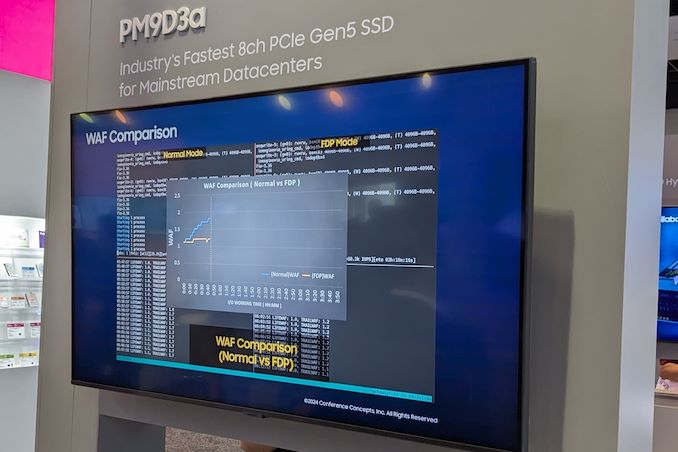
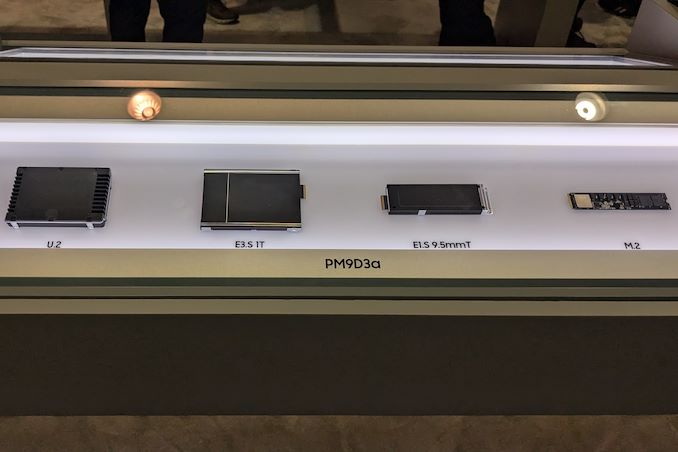
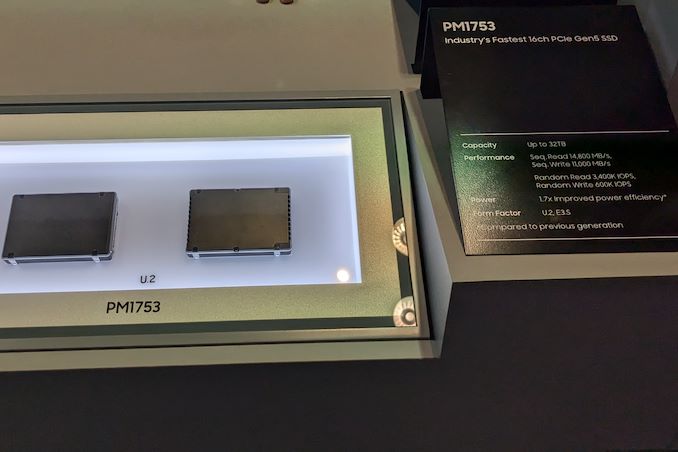








3 Comments
View All Comments
James5mith - Tuesday, August 13, 2024 - link
"Samsung claims a 1.7x performance improvement and a 1.7x power efficiency improvement over the previous generation"So basically 1.7x performance at the same power draw to result in both of those marketing metrics.
Silver5urfer - Wednesday, August 14, 2024 - link
When will the OEMs implement U.2 in Mainstream class motherboards ? I think never. Because many people are fine with using garbage M.2 SSDs over SATA ports and nobody even know SAS connectors which build upon SATA and Enterprise SAS has PCIe4.0 class connectors.Also people just simply want spec sheets for M.2, the PCIe bandwidth is all the focus. Nobody even sees how the TBW is / Endurance. Stability of the SSD in NAS or high workloads 24.7 and other aspects.
I mentioned already a few times that PCIe3.0 SSDs had very good TBW ratings and PCIe4.0 dropped the ball very hard. Now we barely have anything in PCIe5.0 M.2 SSDs.
Sabrent had 6400TBW for 4TB, now its less than 3000TBW for most. SN700 PCIe 3.0 NAS SSD has 5100TBW, Seagate did 530 with 5000+ TBW but now they do not, and most importantly most of these SSDs are failing if you see the ratings in Amazon, or in STH server forums.
Now Samsung is so proud of their QLC, and consumer QLC will be complete pos junk. Esp given how poor their Firmware and QC were for 980/990 pro. WD Black as well, absolute joke. 8TB 850X has 4000TBW lol, even a Samsung 860 Pro MLC SSD from bygone era had 4800TBW in SATA 6Gbps for a 4TB drive.
Mechanical drives get bad rep, but those are the only ones which are reliability running without BS issues and they are also having high capacity. I can get a 20TB OptiNAND WD Red Pro / Gold for under $400 during discounts, that is a top drive btw for those who are unaware in HDD technology. There are more expensive ones, and still they all are cheaper than any 8TB M.2 SSD.
On top all these companies esp WD and Samsung, advertise "Gaming" which is even more foolish, esp making people fools. There's absolutely no improvement in game performance when using SATA vs PCIe SSDs. Only advantage is seen in loading that too modern garbage optimization in games shows. Otherwise no perceived advantage. Direct Storage does not do anything either.
Too bad Storage is nowadays seen as last factor since most consumers are only interested in spec sheets, lack of knowledge, many dont even store Movies and Games in offline format.
I will wait for a good HEDT option or just buy a used X299 or older Xeon and a bunch of SAS Expander / HW RAID cards for a homeserver.
SanX - Thursday, August 15, 2024 - link
I agree about QLC garbage, i afraid recently to touch even TLC drives actually, but have question about U2. Why exactly mainstream mobos need U2? All server motherboards have it, isn't it? I have U2 on motherboard but still have not found any advantage of it over M2 -to- PCIe5.0 adapters.I can place there 4 NVMe drives + one on its own M2 connector and if use 4x bifurcation then probably the whole amount of drives could reach 4*4+1 = 17, all with the whopping up to 12-15 GB/s speed